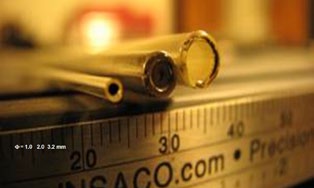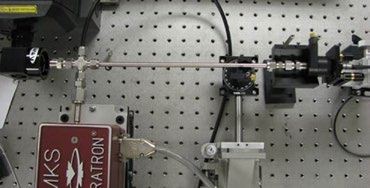Tech Briefs
Savannah River National Laboratory
Apparatus for SERS Analysis of Gases
Researchers at the Savannah River National Laboratory (SRNL) have developed an optical cell that is suitable for the use of surface-enhanced Raman spectroscopy (SERS) for gaseous samples.
Background
Raman spectroscopy is a known technique of identifying the molecular composition of gases and liquids. Light, such as laser light, is directed onto the substance in question and interacts with the electron cloud of the molecules of the substance to an extent determined by the molecular polarization potential of the molecule. The oscillating electrons emit light primarily at the frequency of the incident laser (Rayleigh scattering). A small fraction of the light emitted occurs at different frequencies (Raman scattering), which correspond to vibrational energies of the molecules in the substance. The shift in the emitted photon’s frequency away from the excitation frequency is known as the Raman shift. The pattern of Raman shift frequencies is a spectral fingerprint that allows identification of the molecular components of a substance. Surface enhanced Raman spectroscopy (SERS) is a technique that is used to enhance the relatively weak Raman effect.


Different diameter capillaries

Capillary
At a glance
- Reduced concerns of sample flammability
- Permits molecular identification
- Improved detector sensitivity
- Permits analysis in humid environments
- Cost effective
- U. S. Patent 9,007,576
A Better Alternative
This invention relates to a waveguide for use with surface enhanced Raman spectroscopy, a flow cell for introducing a sample into the waveguide, and a method of applying nanoparticles.
This device is an optical cell that is suitable for the use of surface-enhanced Raman spectroscopy (SERS) for gaseous samples. It utilizes a specifically modified glass capillary and holder that simultaneous allows gas flow through the capillary, exposure of the capillary interior to laser light, and collection of light scattering arising from the SERS effect. The capillary has an optically thick base layer of metal to support waveguide-like propagation of light down the long axis of the tube. The layer is topped with a self-assembled (ordered) array of nanoparticles which support plasmonic resonances required for the SERS effect. The combination of the two components allows the SERS effect to be measured over a much wider surface area.

Applicable Uses
An improved Raman method would be of interest to industries which require fluidic analysis. This technology would have applicability in the medical field for detection of proteins or antibodies in filtered serum mixtures. Other possible uses include process analysis of gases (e.g. flue/stack monitoring), monitors for controlled environments such as glove boxes or confined spaces, and as a detector for certain types of analytical instrumentation (e.g. identification of effluents from a gas chromatography column.
Partnering Opportunities
SRNL invites interested companies with proven capabilities in this area of expertise to develop commercial applications for this process under a cooperative research and development agreement (CRADA) or licensing agreement. Companies interested in licensing will be requested to submit a business plan setting forth company qualifications, strategies, activities, and milestones for commercializing this invention. Qualifications should include past experience at bringing similar products to market, reasonable schedule for product launch, sufficient manufacturing capacity, established distribution networks, and evidence of sufficient financial resources for product development and launch.
Download Tech Brief
Contact Information
Savannah River National Laboratory
E-mail: partnerships@srnl.doe.gov